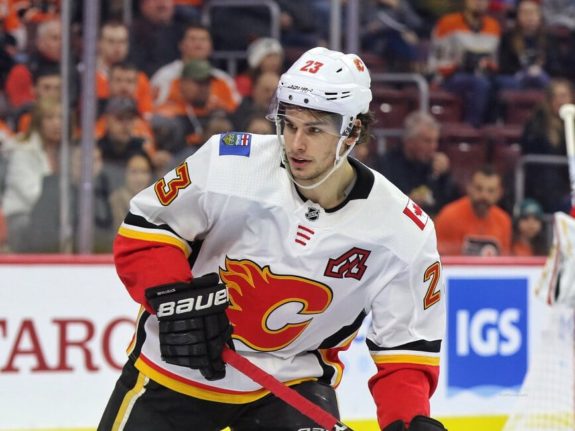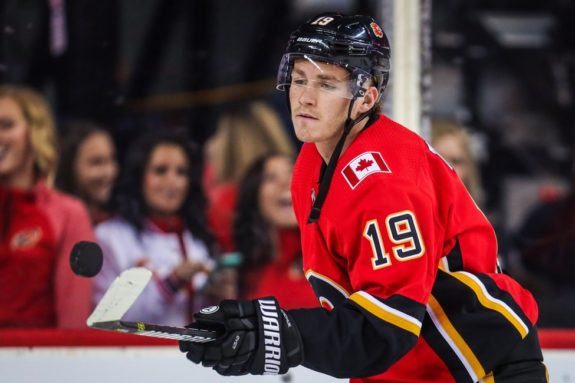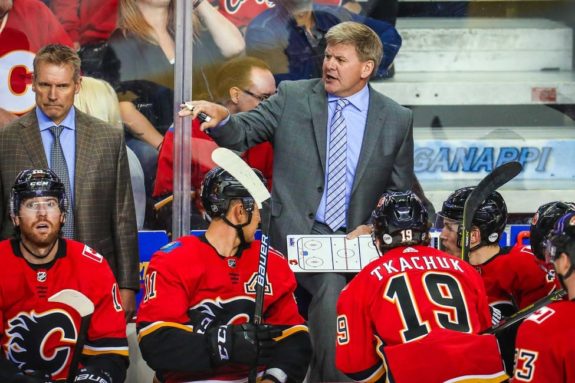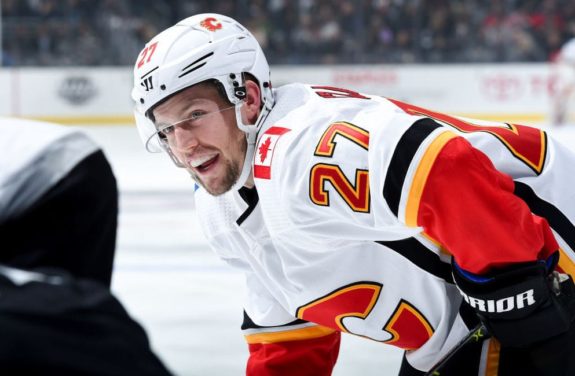Calgary Flames head coach Bill Peters is many things. Bashful about making lineup changes is not one of them.
Although defence pairings were less subject to change, last season featured countless combinations in the bottom-six forwards, and a 3M line that was fairly regular but not immune to some new faces on line two. The only safe bet was the first line of Johnny Gaudreau, Sean Monahan, and Elias Lindholm playing together every night and playing well.
That is, until Calgary’s visit to face the Carolina Hurricanes on Oct. 29, when Peters broke up the Flames’ top line in preparation to face his former team. It was only the second time in the Peters era that Monahan had not started on the first line, the first being in a late-season game against the Dallas Stars in 2018-19, long after the Flames had secured a playoff spot.
Given the Flames’ struggles, mixing up the lines makes a lot of sense. Having a flexible lineup only worked in Calgary’s favour last season.
But starting Monahan on the second line in Carolina just hit differently. It seemed more significant. It seemed like a statement from Peters, not just him “trying something new.”

It also brought to light a philosophical question about how to optimize line productivity: Should you spread your talent through the lineup and try to get more “balanced” production from all four lines, or should you concentrate your talent in the top lines and rely on them to play big minutes?
The Flames appear to have options both ways.
Option One: The Balanced Approach
Putting Monahan on the second line opened up space on the top line for Matthew Tkachuk, who has been one of the Flames’ best players early this season, to play on the right wing. It also gives the Flames a whole new look at centre, with decent depth top to bottom. Perhaps best of all, it squeezed the struggling Mark Jankowski out of the lineup entirely.

There are drawbacks as well. Gaudreau, Monahan and Lindholm are undoubtedly a reliable trio, and there’s wisdom in not messing with a good thing. And moving top-six players down the lineup means the possibility that they will be anchored by the bottom-six forwards, rather than elevate them.
Monahan on the second line could look something like this:
Gaudreau – Lindholm – Czarnik
Tkachuk – Monahan – Bennett
Quine – Backlund – Frolik
Lucic – Ryan – Mangiapane
When Peters arrived in Calgary, he candidly said he was “more of a pairing guy than a line guy.” (from ‘How Bill Peters managed his forward lines last year and what that means for Calgary’s trios this season,’ The Athletic, 09/04/2019) Well, this lineup would sure make a “pairing guy” happy. Each line features a pair that has a good track record.
Lindholm and Gaudreau are almost automatic. Tkachuk and Monahan are two highly-skilled guys who have logged decent time together on the power play. Mikael Backlund and Michael Frolik have a good history and chemistry on the 3M line. And Andrew Mangiapane and Derek Ryan were a very productive pair for the Flames down the home stretch of last season.
Each line is rounded out by somewhat of a wild card. But if you want depth at centre, this may be something to try. Austin Czarnik, who is currently injured, could be replaced by Alan Quine or Dillon Dube to fill in the top six.

If you want to spread talent, but also like Gaudreau and Monahan together, here is another option:
Gaudreau – Monahan – Bennett
Tkachuk – Lindholm – Frolik
Lucic – Backlund – Czarnik
Mangiapane – Jankowski – Ryan
This one feels a little more galaxy-brained. But those top two lines still look very productive, and any team would be lucky to have Backlund at 3C. Sam Bennett seems to play his best when he is not expected to drive a line and has more skilled players around him. Czarnik has been decent when healthy.
Option Two: Concentration of Talent
The prevailing wisdom throughout the NHL seems to be to play your best players together in the top six and then lean on them to produce the most. More skill, more ice time, it just seems to add up.
It’s hard to imagine the Boston Bruins breaking up the Perfection Line just to give their grinders a boost. And the Colorado Avalanche’s top line with Nathan MacKinnon, Mikko Rantanen and Gabriel Landeskog is just too good to split up.
There’s little doubt who the Flames’ top-six forwards are, at least for now (it’s still early). To keep them in the top lines, here are two potential options:
Arrangement One:
Gaudreau – Monahan – Lindholm
Mangiapane – Backlund – Tkachuk
Lucic – Ryan – Bennett
Quine/Czarnik – Jankowski – Czarnik/Frolik
Arrangement Two:
Gaudreau – Monahan – Tkachuk
Mangiapane – Backlund – Lindholm
Czarnik/Quine – Ryan – Dube
Lucic – Bennett – Frolik
Again, feel free to slot Quine or Dube in for Czarnik while the latter is injured.

While those top-two lines look extremely tempting, the bottom six is nothing to write home about. With these arrangements, you are living on a prayer that Bennett, Czarnik and Ryan can elevate their game in a big way.
Or perhaps you’ll be living on a different prayer, that your top two lines won’t burn out playing 23 minutes a night. The Connor McDavid and Leon Draisaitl model seems nice in theory but is probably not sustainable for most teams. (from ‘Willis: Analyzing the risk of heaping heavy minutes on Connor McDavid and Leon Draisaitl,’ The Athletic, 01/09/2019)
There are pros and cons both ways.
The Flames Have Options
To nobody’s surprise, after a tough loss in Carolina, Peters went back to his tried and true top line for the next game against the Nashville Predators. It did not appear to be going well at first, but that story had a happy (and thrilling) ending for the Flames.
Moving Monahan or Lindholm to the second line once in a while could be beneficial for the Flames’ long-term success, as it provides much more palatable centre depth.
The rumors surrounding Peters are that he is frustrated, even outwardly grumpy at times, because of the way this season has started. One can only hope that moving Monahan to line two in Carolina was a calculated move, not a desperation move, from the coach.
The Flames have options. Now’s the time to think outside the box and find what works, even if that means trying things the players are not accustomed to.